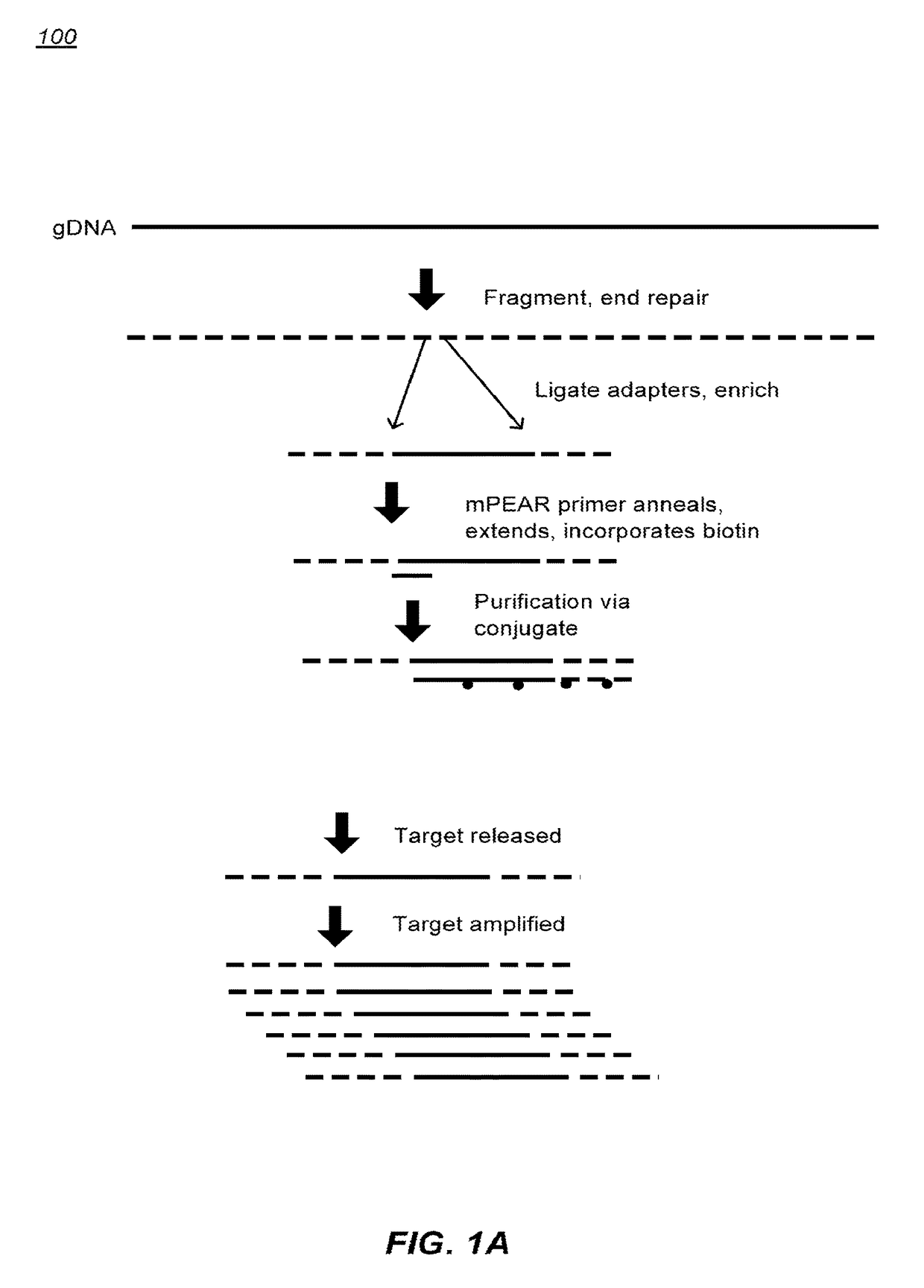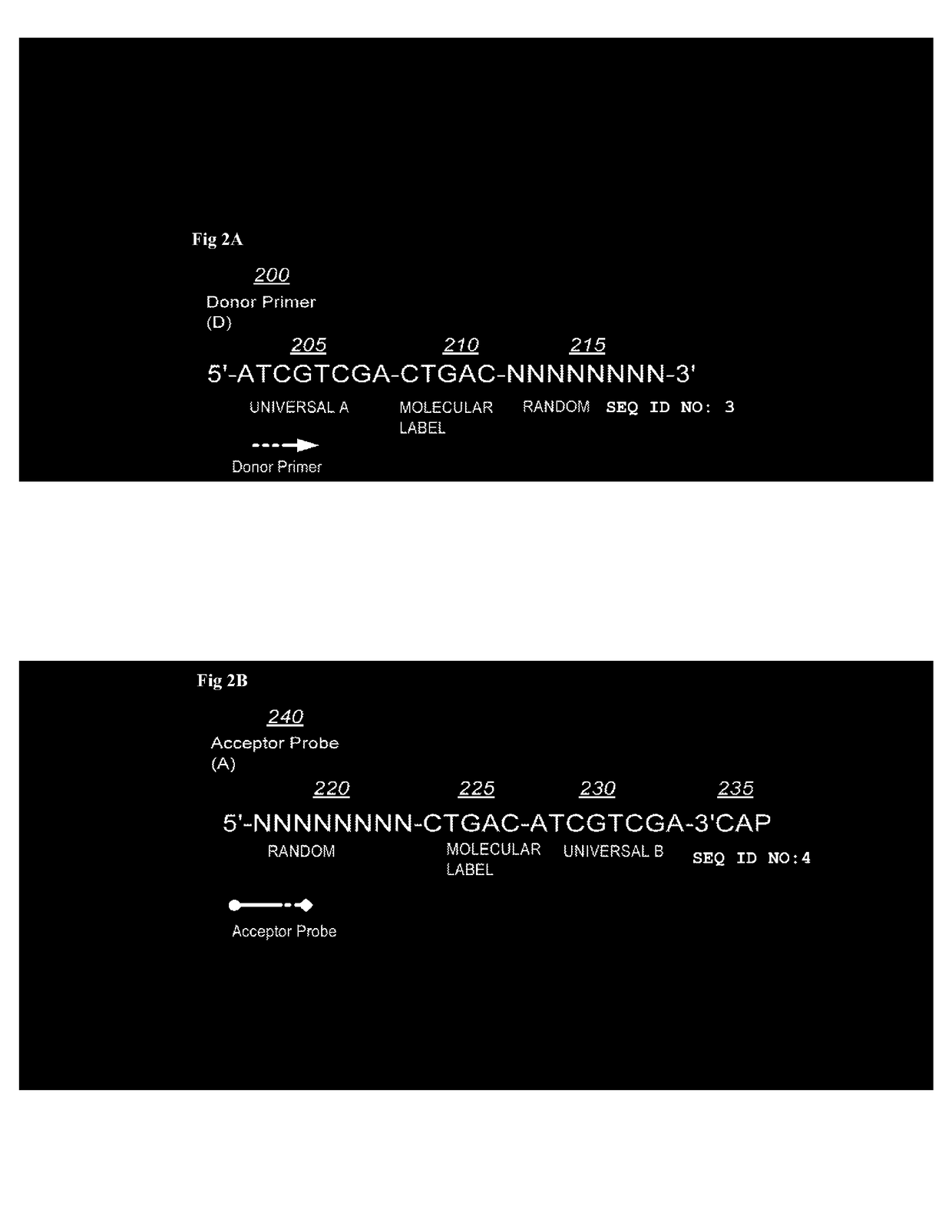Methods of sample preparation
a sample preparation and sample technology, applied in the field of nucleic acid sequencing, can solve the problems of dramatically increasing bias, affecting the alignment of sequences, and affecting the assembly of genomes on the generation sequencing platform,
- Summary
- Abstract
- Description
- Claims
- Application Information
AI Technical Summary
Benefits of technology
Problems solved by technology
Method used
Image
Examples
example 1
otocol for mPEAR-Generated Libraries
[0297]Obtain input polynucleotide. Generally at least 50 ng of high molecular weight genomic DNA (gDNA). Fragment the gDNA.
[0298]Fragmentation:
[0299]Multiple fragmentation methods are suitable. Fragmentation by shearing can be used (e.g. Covaris). The mean fragment size can be approximately 100, 200, 300, 400 or more nucleotides but may vary depending on sequencer platform used. The fragment size can be greater for third generation sequencing technology.
[0300]Re-suspend DNA in 75 μL 1× Tris-EDTA (TE) buffer. Add resuspension mixture to glass Covaris tube. The following settings can be used: duty cycle 10%, intensity 5, cycles / burst 200, Time 120 s.
End Repair and Adaptor Ligation:
[0301]Blunt ends can be generated. A-tailing can be done for Illumina library generation. For other sequencing platforms, A-tailing may be optional.
[0302]End Repair
[0303]Add ligase buffer first to beads. Make master mix.[0304]Prepare the following reaction mixture in a 0.5...
example 2
Adapter Design for mPEAR
[0319]Adaptor sequences can consist of a universal sequence at the 5′ end, a 3 nucleotide sequence for directional information, and a 4 to 6 nucleotide molecular barcode at the 3′ end. Incorporating molecular barcodes can allow for multiplexed target enrichment and sequencing. DNA samples can be individually fragmented, end repaired, and adaptors ligated. Because each sample can have a barcode, the mPEAR step may be multiplexed, dramatically reducing cost and increasing throughput by eliminating individual sample processing steps post library generation. mPEAR library generation with Genome RAPELLing is amenable to all sequencing platforms. Sequencer platform specific adaptors are incorporated through a low cycle PCR reaction after elution from streptavidin beads. Shorter adaptor sequences allow for greater ligation efficiency and more precise size selection of library molecules. Examples of suitable sequence are shown in FIG. 14
Example 3: mPEAR
[0320]Prepare ...
example 3
g Diagnostics
[0333]TELA reactions are prepared on a human DNA sample (e.g a population of human skin cells, suspected of being cancerous). Cells can be lysed using detergent and heat and approximately 15,000 copies of diploid DNA are precipitated via cholorform / ethanol extraction. A resuspension of DNA can be collected with approximately 10,000 copies of haploid DNA. A library of 100 TELA primer sets can be applied to the sample of DNA. Primer sets within the library can contain locus specific sequences for various oncogenes and tumor suppressors known to be associated with skin cancers. Each primer also can contains a barcode sequence. Primer extension reactions are conducted with similar reaction conditions as described herein with Klenow fragment polymerase. Subsequent PCR amplification, using universal priming sites (via the TELA primers) and degenerate primers can increase barcoded DNA yields to 10 ng.
[0334]The sample can be sequenced to sufficient coverage (e.g. 500) using a m...
PUM
| Property | Measurement | Unit |
|---|---|---|
| Tm | aaaaa | aaaaa |
| temperature | aaaaa | aaaaa |
| total volume | aaaaa | aaaaa |
Abstract
Description
Claims
Application Information
 Login to View More
Login to View More - R&D
- Intellectual Property
- Life Sciences
- Materials
- Tech Scout
- Unparalleled Data Quality
- Higher Quality Content
- 60% Fewer Hallucinations
Browse by: Latest US Patents, China's latest patents, Technical Efficacy Thesaurus, Application Domain, Technology Topic, Popular Technical Reports.
© 2025 PatSnap. All rights reserved.Legal|Privacy policy|Modern Slavery Act Transparency Statement|Sitemap|About US| Contact US: help@patsnap.com



